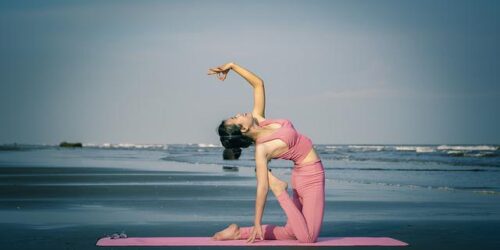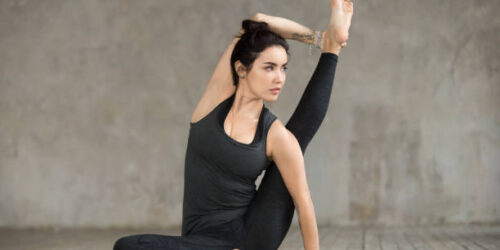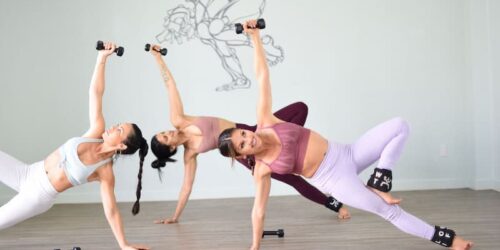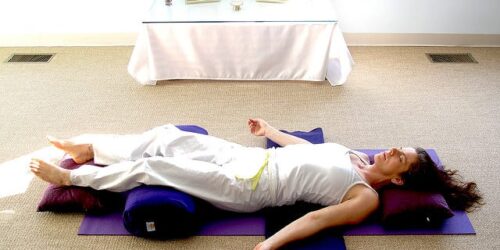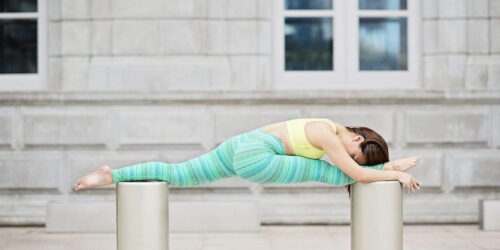What Is Yoga Alignment? Why Is Important
First, what is yoga alignment?
Alignment is the term we use in yoga to describe the precise way to do any given pose in order to maximize its benefits and minimize the risk of injury.
From the outside in, yoga may seem like just another physical activity. While it does offer many of the benefits of exercise, it also has some subtleties that make it difficult to teach yourself.
Please read on for more information about yoga alignment as I provide more specific examples in the post.
Table of Contents
What Is Yoga Alignment?
Yoga alignment describes how the body is set up in asanas (postures). Although it can mean much more, this primarily refers to drawing straight lines and stacking bones. A picture-perfect shape and perfect angles are not the only requirements for alignment. Contrarily, it involves aligning each person in a pose, utilizing their physical capabilities, and upholding a number of fundamental principles in a flexible manner. No matter the individual’s level of flexibility or mobility, their shape or size, or the use of yoga straps, blocks, or other props, alignment can be achieved. While maximizing the benefits of each asana and lowering the risk of injuries are alignment’s primary objectives, it can also refer to forming idealist pose shapes and angles with the body that are thought to be attractive.
The Yoga Alignment Paradox
On the one hand, we are aware that no two bodies are the same and that the way a pose makes you feel supersedes its aesthetic appeal. We’ve been warned not to hold ourselves to unreasonable standards or try to strike the ideal pose. On the other hand, perfect alignment is always shown, explained, strived for, and fixed. How can we reconcile these two contradictory instructions? Should adherence to alignment be abandoned in the interest of acceptance?
The way you strike the yoga pose matters. Making the pose appear attractive is not the only goal of alignment.
The most secure way to adopt the posture is typically provided by the proper alignment. For maximum stability and to reduce stress on the joints, this frequently entails stacking the bones.
In spite of your best efforts, you are more likely to sustain an injury if you attempt to force yourself into a simple or even a seemingly complex pose. Accepting assistance when needed is a necessary component of acceptance. This in the context of contemporary yoga refers to Iyengar’s invention of liberal prop use. You can take on more postures while ensuring safe alignment if you have props.
A truce between your intellect and your emotions is necessary to solve the alignment paradox. Intellectually, you watch the instructor strike a pose, then you watch yourself and attempt to imitate the instructor. You don’t mind where you stand emotionally in the teacher’s eyes. You develop the awareness to feel the pose in your body, to recognize when you need assistance, and to let yourself take it.
Correct Alignment Matters In Yoga
Reduces Your Risk Of Injury
Some general guidelines for alignment are focused on preventing injuries. Some of these guidelines are intended to prevent some of the typical reasons why yoga injuries occur. One of them is locking your joints and hunching your shoulders over your ears while inverted.
By evenly and harmoniously activating all of your muscles, proper yoga alignment also makes sure that you develop physical strength. By doing this, you can increase your strength without putting an undue amount of stress on any one muscle or joint.
The amount of stress placed on the ligaments holding your spine together is reduced when it is properly aligned. Similar to this, alignment lessens the abnormal wear and tear on your body’s joints. assisting you in avoiding later illnesses like arthritis.
Biomechanical Efficiency
Optimum muscle and joint alignment maximizes your available power from a biomechanical standpoint. Because of this, you can complete your tasks faster and with greater success. Your joints are stacked together when you have proper alignment, which improves the efficiency with which you can employ your strength. There is less strain as a result. Additionally, breathing will be simpler.
Conserve Energy
You work more effectively when everything is in alignment. You are then able to effectively use the energy that your body has. Since you don’t need to make up for being out of line, you can use less energy as a result.
Reduces Fatigued
Yoga practice can be very difficult, especially when you first begin. The primary cause of this is the exhaustion that results from training. But if you do the yoga poses properly, you can significantly reduce this level of fatigue.
The Yoga Journal claims that better alignment allows for increased blood flow. As a result, you can use your muscles more effectively and conserve energy. less fatigue as a result.
Builds Strength
Just like cycling or swimming, yoga is an exercise. Your joints will stay in the right places if you have good alignment. Power is generated as a result of the muscles working at their best. It also assists in preventing your muscles, joints, and spine from adopting uncomfortable angles and positions.
Energy Flow
The best way to understand alignment is to think of it as a canyon wall that permits rivers and streams to flow. When you practice yoga, alignment opens a channel for energy to flow freely throughout your body.
Energy flow is essential for your physical health, but it also benefits your mental and spiritual well-being. Your body receives energy where it is most needed by allowing energy to flow through it.
Appearance
Correct alignment also makes it easier for you to be conscious of your posture outside of yoga sessions. In the end, this greatly contributes to improving good physical posture and appearance.
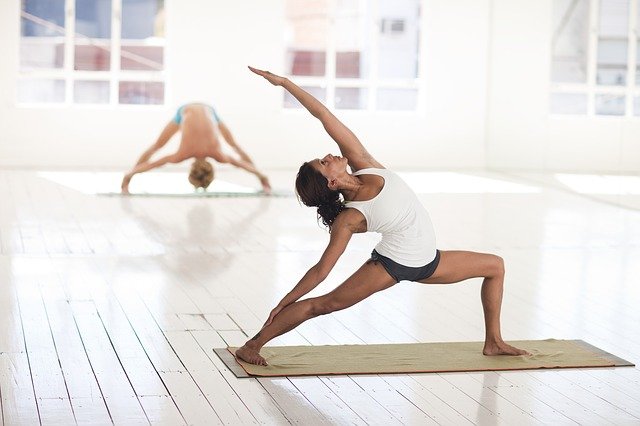
Key Alignment Principles And Their Application
Align With A Solid Base & Start From The Ground Up
Align yourself while assuming a posture and gradually contract your muscles. If your feet are on the ground, begin by activating and positioning each body part as you work your way up from the bottom of your feet toward your arms and head. Start with your hands, arms, and head when practicing an inversion, then move on to your feet. Whatever pose you are doing, start by aligning where it makes the most sense for you and work your way into each part of the body one at a time.
Be Present & Move Mindfully
As you breathe and move, keep your focus on each individual body part. Moving with focus and attention can significantly alter how you practice. You can further develop your yoga practice by using this principle to help you become more aware of your body.
Engage Body Areas Based On The Pose
The body must be properly positioned in order for the appropriate muscles to contract and the appropriate connective tissue to stretch. The precise muscles and connective tissue that should be stretched and strengthened is covered in many anatomy books. Every yoga pose alignment example we provide briefly touches on this. You will experience more benefits, advance more quickly, and become more in tune with your anatomy if you have a better understanding of this.
Keep The Neck In Line With The Spine
This is the most important guideline to follow when performing yoga asanas and is required in almost all of them. It is crucial for the proper operation of processes like energy flow, breathing, and stability for the neck and spine to be in alignment. Whether performing a back bend, forward fold, or inversion, protecting the neck should always come first. Your yoga practice and your daily life outside of yoga will both benefit from developing this habit.
Stack Joints
While practicing yoga, aligning your joints will give you additional support, stability, and strength. In the plank position, for instance, the shoulders should be stacked above and parallel to the wrists and elbows. Another illustration would be to maintain the knee and ankle in alignment while performing the Warrior 1 Pose.
Mind The Micro-bends
In a perfect aesthetic world, when we practice yoga, every line we make with our bodies is straight. In some situations, particularly those involving the knees and elbows, fully straightening is not always the best option because there is a chance of joint hyperextension. The elbows in Downward Facing Dog Pose and the knee of the standing leg in Tree Pose both benefit from this. Utilize this idea to increase muscular activity—microbending is also crucial!
Change Angles As Necessary
Many asanas that call for bending at the knees and elbows commonly instruct practitioners to make a 90° angle.This doesn’t mean that deviations from that angle are wrong.If an angle isn’t working for you, change it so that it feels right for your body. It’s fine to bend the elbow or knee at an angle that is steeper than usual. To determine what angle is best for you, experiment using this principle.
Never Overdo It
It’s best to avoid overcompensating when following alignment instructions. In Mountain Pose, two examples would be over-broadening the chest and tucking the tailbone past neutral. While practicing, apply this idea to help the body find balance.
Perform A Number Of Cues That Work For You
Sometimes an instructor will give too many cues for their students which could become overwhelming. Don’t feel obligated to perform each and every cue if there are too many; instead, pick out 3–4 that you think you can execute the best, and work on the remaining cues later. Occasionally, a teacher may give instructions that are incompatible with what your body is capable of doing. If you receive conflicting cues, pick the one that will be easiest for you and your body to accomplish.
Utilize Yoga Props To Your Advantage
yoga bolsters, blocks, blankets, and straps. can either be used as extension (to connect body parts) or as support (to help reinforce or prop up) for the body while practicing. Utilize them to create a stronger base and maintain alignment while you train.
Use Outside Means For Feedback
Feedback is important so that you can see how your body is actually positioned— and you may look much different than you think! There are other ways to determine if your movements are aligned, though it is best to discuss them with a certified yoga instructor. You’ll understand how to position your body into each posture most effectively if you receive feedback both verbally and visually. You can learn and apply methods to determine your alignment by reading this blog post.
Final Thoughts
What is yoga alignment? was the post’s main topic.
A simple definition of alignment is how we position our bodies to get the most out of a yoga pose without feeling uncomfortable or running the risk of hurting ourselves.
Although alignment is crucial to a successful yoga session, it is a subject that isn’t always clear or widely accepted.
Every movement we make involves a net sum of our various body parts. All of your body’s parts can move in unison when you’re in alignment.
Please leave a comment if you have any questions about what yoga alignment entails. If I see it, I’ll respond right away.
I really appreciate you reading. Thank you!
